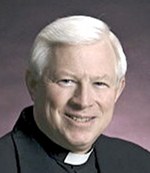Editor’s note: After the Saturday funeral for Bill Wilcox, I asked the Rev. Craig M. Kallio of St. Stephen’s Episcopal Church a few questions about Wilcox’s cremation and burial in St. Stephen’s Memorial Garden.Â
Here is his response to my question about cremation, and Wilcox’s burial in a handmade linen bag tied with a hand-knotted cord.Â
Kallio: Bill was cremated and interred in our Memorial Garden. This burial option has become more popular among Episcopalians within the last 20 years, though the custom is quite ancient.
One reason for opting to use cremation is that of being good stewards. It takes into consideration the simplicity and cost. Rather than going with an elaborate funeral, our resources are better used elsewhere.
Our Book of Common Prayer uses the phrase “Ashes to ashes, dust to dust.” It references Genesis 3:19, where God says to Adam, “By the sweat of your brow you will eat your food until you return to the ground, since from it you were taken; for dust you are, and to dust you shall return” (New International Version). On Ash Wednesday, when Lent begins, we spread ashes on our forehead as the priest says, “Remember, you are dust, and to dust you shall return.”
The linen bag and the knotted cord are bio-degradable so that, in time, the ashes and the bag are absorbed into the soil.
I also asked Kallio about the small, brown hand-crafted wooden box that held Wilcox’s ashes during the funeral and was used to carry them out to the memorial garden. During the service, the box was covered with a white cloth.
Kallio: The material that covered the box is called a “pall.” It serves as a reminder that when we enter the church, we are all equal in the eyes of God. Hence, whether the casket is ornate and expensive, or simple and inexpensive, we cover it with the pall so that the “pauper” is equal in stature to the “king.” We use the small pall for ashes and a large one for caskets. Once the body/ashes leaves the church, the pall is removed.
During the service, the ashes are placed on a regular table.
The cloth was woven with the cross at the center on top. That tall candle behind is the Paschal candle, which is a reminder of Christ’s presence. The word “Paschal” is a reference to Easter and Christ’s resurrection from the dead.

Leave a Reply